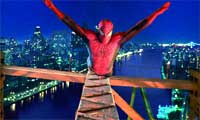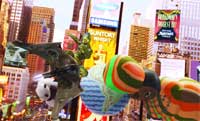
Sony Imageworks used its proprietary Bonsai system for compositing on the film.
|
The packed theater goes dark. The screen lights up flashing a montage of Spider-Man comic book panels. Danny Elfman's ominous score marches across your ears. A portentous title sequence of CG spider webs and shattering screen credits tumbles by. Your heart starts pumping with eager anticipation that this obvious film homage to the superhero legend will bring story and visual effects together into exhilarating harmony.
That expectation was met and exceeded by the Columbia Pictures' rendition of Stan Lee's story of a nerdy teenage boy who gets bit by a radioactive spider, inherits all its powers, and decides to fight crime.
It took 40 years for the web slinger to become an overnight movie success. In 1962, Lee's revolutionary character first hit the newsstands in the comic book Amazing Fantasy #15. And it's been 17 years from the time the movie first went into development. Many scripts, studios, directors, lawsuits and bankruptcies later, Spider-Man has finally made it to the big screen.
At a May 3, 2000 Sony Pictures Entertainment/Marvel Comics press conference, Spider-Man director Sam Raimi explained, "I don't think there's ever been a time in history, up until now, that you really could have made this Spider-Man picture. Where you can really create these digital cities and we can soar with a Spider-Man above Manhattan. What I want to do is show it like you'd show a great Olympic skating routine. He's not a muscle-bound brute. He is a beautiful dancer who soars above the skyline, and it'll be the work of an acrobat, the work of a gymnast, the work of all the finest performers in the art of physical what-have-you. I hope it will become a thing of beauty that 20 years from now, people will still enjoy watching."
Effects guru John Dykstra (Star Wars, Silent Running, Batman Forever) was brought aboard by Raimi as visual effects designer to oversee the creation of 475 effects shots in the 121-minute flick. Raimi and Dykstra then chose Sony's own in-house effects team, Imageworks, to complement the quirky visual style of the popular genre director Raimi, who's credits include the cult classics Evil Dead and Darkman.
Other Spider-Man Imageworks visual effects leads included visual effects supervisor Scott Stokdyk, animation director Anthony LaMolinara, lead animators Bill Diaz and Spencer Cook, computer graphics supervisors Ken Hahn, Dan Eaton and Peter Notz, and a crew that swelled at peak production time to over 200 artists.
"As visual effects designer," says Dykstra,"I had the opportunity to be more involved with the storytelling aspect of the movie and less involved in the mechanics. I got to spend more time thinking about the dramatic arc of visuals throughout the film. Now I'm in the position of not just being able to execute an idea but saying, 'How can we enhance it?' Being a designer allows you to comment on the creative component of the film."

The Green Goblin and Spider-Man were keyframed while crowds were motion captured via a Vicon system.
|
Pre-Post
Even though the effects crew started planning and pre-production over two years ago they knew the project would be a challenge. "When I first read the script," recalls Stokdyk, "I thought, wow, this is really cool, but it's going to be really hard to do some of these effects. Then I realized that was our challenge. John Dykstra, [myself] and the other artists at Imageworks had to figure out how to get all these effects for the movie to work."
"For example," notes animation director LaMolinara, "shooting webs looks great in the comic. When we first started doing tests it looked ridiculous. It just didn't come off. Then finally we got to something that looked very nice." For those CG enthusiasts it turns out that the web is actually a single strand of "fur." Built in Side Effects Houdini, using VEX, the web is a soft-body dynamic that Imageworks artists custom sculpted by adding various amounts of procedural noise.
"Sam wanted to make this movie to be real," says Dykstra. "It's New York, warts and all, not a stylized, stage version like Gotham or Metropolis. In many cases those are real plates of the real city right down to the rust stains and pigeon droppings.
"Sam also wanted the audience to have the experience of flying with Spider-Man though the buildings," continues Dykstra. So in the same way that a stunt skydiver has a stunt cameraman that follows him and shoots his routine, Spider-Man would have a "personal cameraman" so the audience could have the excitement of swooping through the city from that point of view.
To match the live action scenes with the visual effects, Imageworks created a virtual New York City set. Originally, says Dykstra, they planned to use photogrammetry, but that technique did not supply enough high frequency detail when they tracked through the buildings. So instead they selected 17 prominent buildings, sent a crew to New York City, surveyed the structures with conventional techniques, modeled them and then mapped on 60,000 corresponding high-resolution photographic textures to build the high rise CG version of the city.
The background, pan and tile "virtual plates" alone would run up to 90 layers deep, says CG supervisor Hahn. "With all the additional layers on top of that, the worst was a couple hundred. The last swing shot at the end of the movie was easily several hundred."
Sony Imageworks used Pixar's RenderMan to output the buildings and texture layers and Mental Images Mental Ray for the reflection layers on buildings when Spidey is swinging past them. For compositing they used their in-house proprietary system called Bonsai.
Swooping through NYC
The next challenge was Spider-Man himself and his nemesis, the Green Goblin. How did they create a believable character that can swing effortlessly from building to building? The Imageworks' solution was that the singular superhero is actually a trio of Spider-Men. Tobey Maguire did all the Peter Parker scenes and some of the full costumed Spider-Man scenes. Some of the more challenging stunts were performed by his stunt double. And finally, the Spider- Man in the homemade costume that crawls up a high rise, dodges razor bats in a burning building and swoops gracefully hundreds of feet in the air landing on the Queens- borough Bridge is an animated character that blends nearly seamlessly with his live action counterpart.
The modeling started off with a full body scan of the actors in costume, says Diaz. The body scan comes out at very high resolution so the modeling department built a second model around it. "The second model is much more efficient in the way it uses its points and the geometry," continues Diaz. The character set-up team scaled the size of the digital skeleton to match the proportions of Tobey Maguire's and Willem Dafoe's body scans, then went inside the model and built a rigging or internal "skeleton." (This digital skeleton rig is what drives the computer model's movements.) Next, they added a highly complex yet workable series of joints and muscle deformations that had a similar range of motion to the joints and muscles on a human, then applied final cloth and costume textures.
So how do you make the action convincing? Imageworks tried motion capture and did extensive tests with athletes from Cirque du Soleil. However, animation director LaMolinara points out, "Motion capture captures the motion of a human and this is a superhuman so they would have to come up with superhuman motion capture system and perhaps a superhuman to stand in to be captured." They decided to keyframe animate the lead characters, Spider-Man and the Green Goblin, and use mocap on the crowd scenes.
"The hardest thing in animation is to duplicate human motion," explains Diaz. "Because we have grown up all our lives watching human motion, we can easily realize what looks real or fake. We have to include, what we call all kinds of secondary motion on top of our initial animation, like Spider-man's chest compressing to take a breath when he's getting ready to swing or slight imperfections in the swinging of his legs or arms. Our character set-up team built in a high level of controls for the animators to use, including breathing.
"We did a lot of lighting tests," he continues, "where you take a photo of the stunt person in the Spider-Man suit on location. A team of CG lighters would simulate the exact sort of lighting set-up and nail it down to where they could put the textured CG Spider-Man next to the guy on the live action set and you would not be able to tell them apart."
Pulling the whole thing together included using some very low-tech interpersonal technology as well as state of the art gear. "Our pipeline has improved incrementally over the years," says Stokdyk, "but making films and making the digital effects part of films is still such a collaborative effort, the best way we have to maintain a clear direction is with human contact." Imageworks' daily routine was to screen the previous day's output on the big screen, discuss the shots, then meet with individual artists and in groups to work out problems.
Imageworks uses a hybrid technology system of Silicon Graphics machines and PCs running Windows NT. The hardware is complemented by off-the-shelf software such as Alias|Wavefront Maya and Houdini, and a lot of proprietary tools custom built to work between these two applications. "Our platforms are set up for different functional groups. For example, our animation department is all NT based," Stokdyk explains. "Then for rendering we have our NT renderfarms and Linux renderfarms." Spread out over multiple buildings on the Sony lot the various departments are connected by a Gigabit Ethernet with a HIPPI backbone.
The next adventure
Even as the rush of excitement over their success continues, they are already planning for Spider-Man II. Looking at this movie as getting their CG legs, so to speak, LaMolinara says he feels more can be done on the transition between the live action and CG Spider-man.
"There is more that can be explored in terms of how this character can move across things and what kind of feeling that character has," he says. "I'd like to put in some more idiosyncrasies of Tobey's into the [CG] character."
"There will be inevitability more improvements in the technology," notes Dykstra. "One of the things that you have to realize is that you are always planning two years ahead, so you are promising something you don't know if you can deliver - but you have to take that risk."
Even more important than the technology, Dykstra explains, is the fact that everyone has worked together for two years. "A huge amount of collaboration took place between all the creative departments: art directors Steve Arnold and Tony Fanning, cinematographer Don Burgess, costume designer James Acheson, John Frazier who did the mechanical effects, production designer Neil Spisak, stunt coordinator Jeff Habberstad, editors Mob Marowski and Arthur Colburn, and everyone else. Now that we have worked with Sam Raimi we know what his tastes are and how best to contribute. We already have a communication language, a shorthand, making us hugely more efficient, and it also means that we will have more time to craft the picture and put more quality into the shots."